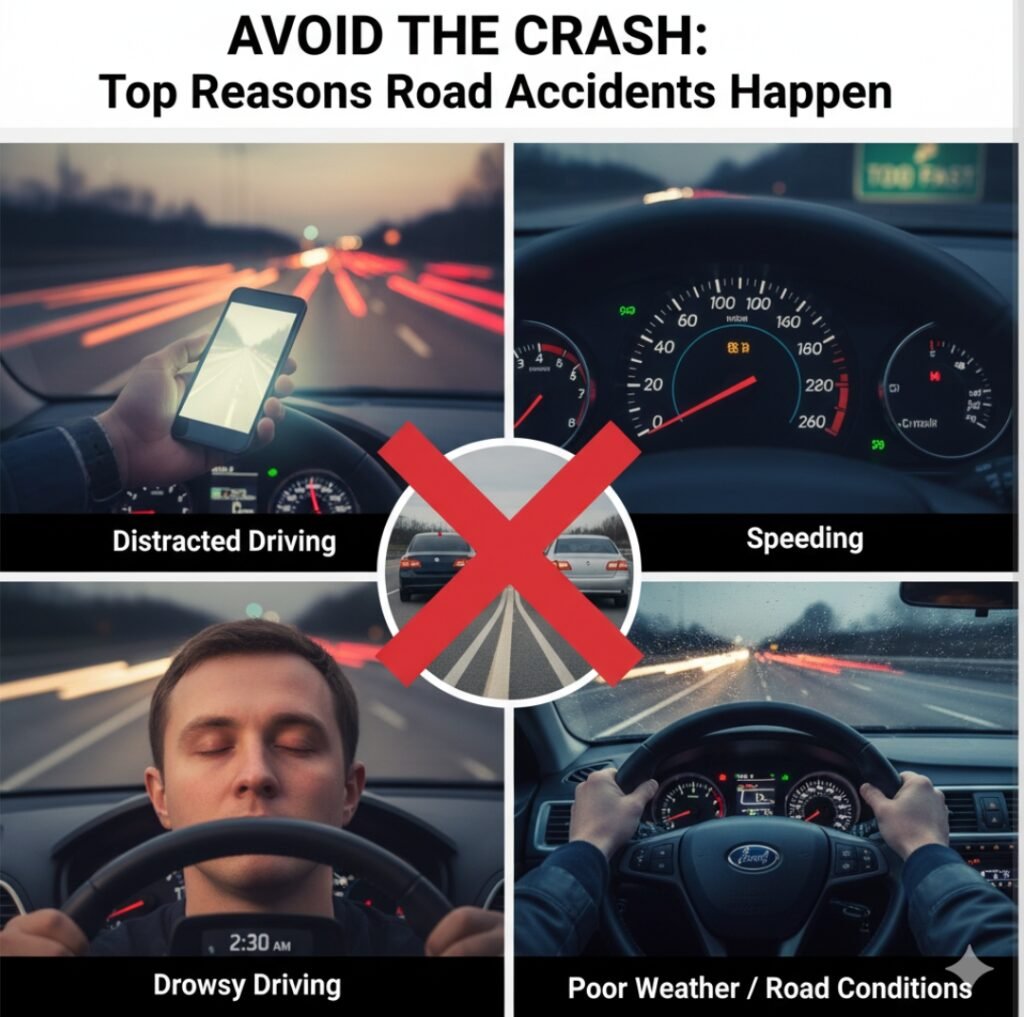Road accidents are an unfortunate reality of modern life, affecting millions worldwide every year. While some accidents are unavoidable, many occur due to preventable factors. Understanding the most common causes of road accidents is crucial for every driver, pedestrian, and cyclist. By identifying these risks, we can take proactive steps to stay safe on the road.
1. Distracted Driving
Distracted driving is one of the leading causes of accidents globally. With smartphones, navigation apps, and infotainment systems, drivers often take their attention away from the road. Even a few seconds of distraction—like texting, scrolling social media, or adjusting the radio—can have severe consequences. Drivers who are not fully focused may miss traffic signals, pedestrians, or sudden obstacles, leading to collisions. Minimizing distractions and keeping full attention on driving is essential for preventing accidents.
2. Speeding
Speed limits are carefully set to ensure the safety of drivers, passengers, and pedestrians. Driving above these limits shortens reaction times, making it more difficult to respond effectively in emergencies. Collisions at higher speeds are often far more severe due to the increased force of impact. Many accidents happen when drivers try to rush through traffic lights, pass other vehicles recklessly, or misjudge road conditions.
One of the most effective ways to stay safe is to drive within posted limits and adjust speed according to road and traffic conditions. For added skills and safety, enrolling in a defensive driving course in Utah can teach drivers techniques to anticipate hazards and avoid accidents before they happen.
3. Drunk or Impaired Driving
Alcohol and drugs impair judgment, slow reaction times, and affect motor skills, making driving under the influence extremely dangerous. According to statistics, a significant percentage of road accidents involve impaired drivers. Even small amounts of alcohol can affect decision-making and coordination. To prevent accidents, it is vital never to drive after drinking or using substances that impair alertness. Instead, use designated drivers, ride-sharing services, or public transportation when needed.
4. Fatigue and Drowsy Driving
Driving while tired can be as dangerous as driving under the influence. Fatigue affects concentration, slows reaction times, and increases the likelihood of microsleeps—brief moments of unconsciousness behind the wheel. Long-distance drivers, shift workers, and people driving late at night are particularly vulnerable. Taking regular breaks, getting enough rest before driving, and avoiding long drives when exhausted are key measures to prevent fatigue-related accidents.
5. Reckless Driving and Aggression
Aggressive driving behaviors such as tailgating, frequent lane changes, and road rage contribute significantly to accidents. Drivers who engage in risky maneuvers or respond angrily to minor frustrations endanger everyone on the road. Practicing patience, maintaining safe distances, and avoiding confrontations with other drivers can reduce the risk of collision. Remember, aggression behind the wheel never leads to faster or safer travel.
6. Poor Weather and Road Conditions
Rain, snow, fog, and ice can make roads slippery and reduce visibility, increasing the chances of accidents. Potholes, uneven surfaces, and poorly maintained roads also pose significant risks. Drivers must adjust their behavior according to weather and road conditions—reducing speed, maintaining greater following distances, and using appropriate tires can help prevent accidents in adverse conditions.
7. Vehicle Malfunctions
Sometimes, accidents occur due to mechanical failures such as brake malfunctions, tire blowouts, or steering problems. Regular vehicle maintenance, including checking brakes, lights, tire pressure, and fluid levels, is essential to prevent accidents caused by mechanical issues. A well-maintained vehicle not only ensures safety but also enhances overall driving performance.
In Conclusion
Road accidents are rarely caused by a single factor. More often, they result from a combination of human error, environmental conditions, and vehicle-related issues. While we cannot control every variable, understanding the main causes—distracted driving, speeding, impairment, fatigue, reckless behavior, weather conditions, and vehicle malfunctions—allows us to take preventive measures.
Safety begins with awareness and responsible driving. By staying alert, obeying traffic laws, and maintaining our vehicles, we can significantly reduce the risk of accidents. Every precaution we take on the road is a step toward protecting our lives and the lives of others. Avoiding the crash is not just about following rules—it’s about cultivating a mindset of caution, patience, and responsibility every time we get behind the wheel.
Experienced SEO Specialist and Web Developer with a strong focus on off-page SEO and guest posting. With 3 years of proven expertise, I help businesses improve their search rankings and build sustainable online presence.
